Initially this guide displays common birds of all types that are flying right now in our area. Use the selectors below to view rare birds, view birds flying any time, restrict the output to a certain shape of bird, or search by name.
New Mexico is on the western edge of the Central Flyway which is one of the major migration pathways between north and south for birds traveling between breeding and wintering grounds along the Rocky Mountains. This has resulted in the state having an incredible diversity of birds with over 550 different species reported. A little more than half of this number are sighted annually on the Pajarito Plateau. Some of these birds are full-time residents, some migrate here for a few weeks or months, and other are only seen briefly as they pass through the region.
This guide features many of the birds known to frequent Los Alamos county by when they are likely to be seen in the area. You can get additional information on local birds by joining PEEC Birders or going to the eBird website. eBird also includes lists of rare bird sightings and birding hot spots.
Bird References
Birdweb
Cornell Lab of Ornithology
eBird
eNature
Institute for Bird Populations
National Audubon Society
New Mexico Ornithology Society
What Bird
xeno-canto
Subject Area Experts (all guides)
Steve Cary (butterflies)
Beth Cortright (insects)
Terry Foxx (invasive plants)
Leslie Hansen (mammals)
Richard Hansen (fish, mammals)
Dorothy Hoard (butterflies, trees)
Chick Keller (flowers, herbarium)
Shari Kelley (geology)
Kirt Kempter (geology)
Garth Tietjen (reptiles)
David Yeamans (birds)
Web Development and Content Management
Pat Bacha
Jennifer Macke
Graham Mark
Akkana Peck
Contact
Please contact us for local nature questions and sightings. We welcome comments, corrections, and additions to our guides.
For more information about local nature, please visit our Nature Blog or subscribe to PEEC This Week.
Make Selection
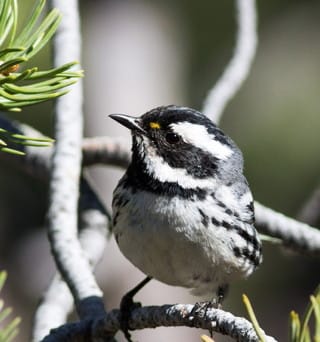 Photo: male by Fyn Kynd 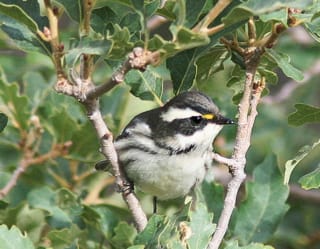 Photo: female by Selvi Viswanathan |  Black-throated Gray WarblerBTYW (Setophaga nigrescens, Dendroica nifrescens)Family: Parulidae (Wood Warblers) Size: 4.5 - 5 in (11 - 13 cm) Flies: Apr 01 - Oct 01 Morphology: adults have have gray backs with white faces and underparts, a black mask, white wingbars, small yellow square in front of the eyes, and white spots on the tail; males have a black throats and black streaks on the sides; females have a black band on the breast but lack black on the throat; immatures like females Status: native; uncommon Food source: mostly insects with a preference for green caterpillars Habitat: shrubby openings in coniferous forest, dry scrub oak, pinyon-juniper, chaparral Typical location: Barranca Mesa Black-throated Gray Warblers are sometimes mistaken for the Black-and-white Warbler, but the latter are rarely seen in the area. These birds are short-distant migrants, traveling from breeding areas in the western United States to only as far south as Mexico. They typically forage by searching for insects among leaves but may also fly out to catch flying insects. In winter, they will forage in mixed flocks. Little is known about the Black-throated Gray Warbler’s nesting habits other than that the nest is of an open cup design made of plant and animal fibers. However, these birds have been observed defending their nests by pretending to have a broken wing in order to distract an intruder. Info Photos Distribution Frequency |
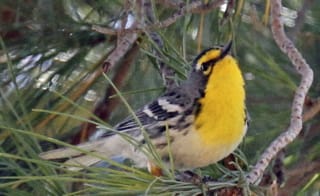 Photo: male by Robin Agarwal 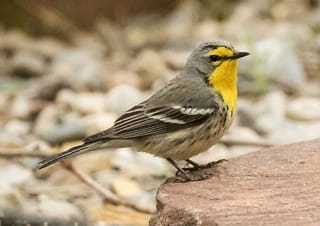 Photo: female by Mouser Williams |  Grace's WarblerGRWA (Setophaga graciae, Dendroica graciae)Family: Parulidae (Wood Warblers) Size: 4.5 - 5 in (11 - 13 cm) Flies: Apr 01 - Sep 15 Morphology: small birds that have a gray back and white belly with black streaks down sides of chest and flanks, yellow chin, throat, and breast, a yellow eyestripe, and a yellow crescent under the eye; females are paler, more brown than males; immatures are similar to adults but duller with less streaks Status: native; locally common Food source: not well known but presumed to almost exclusively eat insects and their larvae Habitat: pine forests, mixed pine and oak Grace’s Warblers spend most of their time in the tops of tall pine trees, making it difficult to see them. They will search among the branches to find insects as well as to fly out and catch them mid-air. Details of the life history of these birds is not well-known. However, males have been observed defending a nesting territory by singing, and females seen to be responsible for nest building. Nests are an open cup-shape and well hidden, often placed in a cluster of pine needles high above the ground. There are normally 2 broods per year. Info Photos Range Frequency |
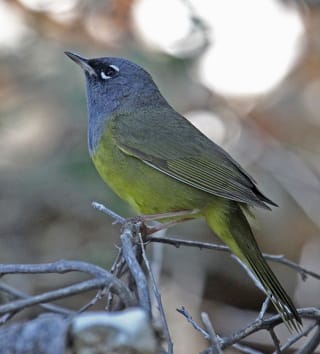 Photo: male by Jerry Oldenettel 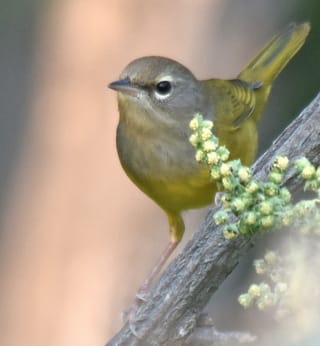 Photo: female by Steven Mlodinow |  MacGillivray's WarblerMGWA (Geothlypis tolmiei, Geothlypis macgillivrayi,)Family: Parulidae (Wood Warblers) Size: 4.8 - 5.5 in (12 - 14 cm) Flies: Apr 21 - Sep 21 Morphology: males have dark gray heads, throats, and upper breasts with olive-colored backs and wings, white crescents above and below the eyes, and yellow underparts; females have gray-olive heads, throats and upper breasts, olive upperparts, yellow underparts, and white arches around the eyes; immature are similar to the females but duller Status: native; common Food source: diet not well known but assumed to consist mostly of insects Habitat: coniferous forest edges, burns, brushy cuts Typical location: Los Alamos Reservoir The MacGillivray’s Warbler is a skulker, hiding out in dense brush, making it hard to spot. It is also a loner, even during migration season. These birds typically forage close to the ground, hopping along looking for insects. They may visit water gardens. Males sing to defend a nesting territory. Nests are well hidden, a few feet off of the ground in the fork of a shrub/tree or in tall weeds. The loosely constructed cup-shaped nests seem to be relatively immune to parasitization by cowbirds. Young leave the nest at a little over a week old. Info Photos Range Frequency |
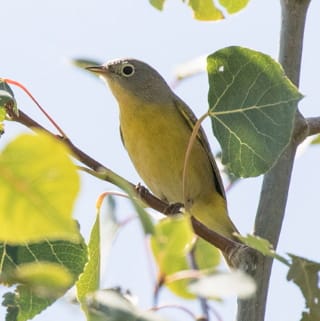 Photo: adult by Mouser Williams 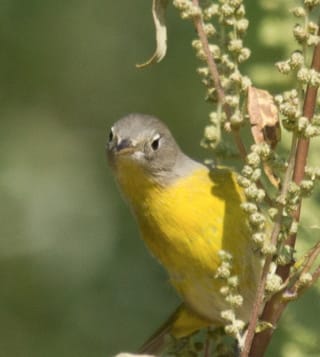 Photo: adult by Rozelle Wright |  Nashville WarblerNAWA (Oreothlypis ruficapilla, Leiothlypis ruficapilla)Family: Parulidae (Wood Warblers) Size: 4 - 5 in (10 - 13 cm) Flies: May 01 - May 15 and Sep 01 - Sep 15 Morphology: both sexes are similar with gray head, olive-green back and wings, yellow throat, breast and belly, and white eyering; immatures look like adults but with a brownish color to back and white throat patch Status: native; rare Food source: insects including beetles, caterpillars, grasshoppers, leafhoppers and aphids; insect eggs Habitat: edges of woodlands, thickets The Nashville Warbler is a small, migrant songbird that breeds in northern areas and winters in Mexico. These birds forage in the lower parts of trees, gleaning insects from the tips of branches and flower tassels. Nashville Warblers prefer to breed in overgrown pastures, making a cup-shaped nest in a well-hidden spot on the ground. Eggs are incubated for 11 to 12 days by both parents and the young leave the nest about 11 days after hatching. Info Photos Distribution Frequency |
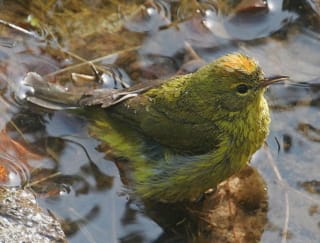 Photo: adult showing orange crown by Hari Viswanathan 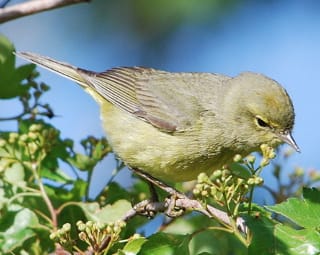 Photo: adult showing hint of orange by Jerry Oldenettel 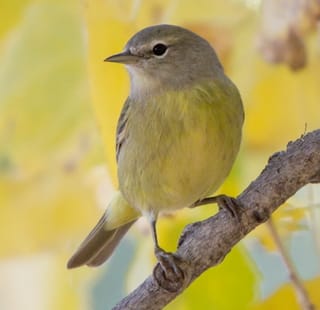 Photo: adult by Mouser Williams |  Orange-crowned WarblerOCWA (Oreothlypis celata, Leiothlypis celata)Family: Parulidae (Wood Warblers) Size: 4.5 - 5.5 in (11 - 14 cm) Flies: Apr 07 - Oct 15 Morphology: yellow to olive-grey coloring overall with a thin white stripe over the eye, a black line through the eye, and a pale partial eyering; thin, sharp bill and square tail; the orange crown patch is inconspicuous and usually only seen when a bird raises its head feathers Status: native; common Food source: mostly insects with some nectar, sap, and berries; feed young on insect larvae Habitat: forest edges, burns, clearings, thickets, shrubby undergrowth The Orange-crowned Warbler is one of the plainer warblers and one of the most hardy. It usually flies solo but may join a loosely associated flock. These warblers tend to forage in low bushes and deciduous trees, flitting from branch-to-branch looking for insects or hopping around on the ground. In addition, they will pierce the base of flowers with their bill to sip nectar. They will also come to feeders for suet and peanut butter. Open cup nests are built low to or on the ground, protected by overhanging vegetation. The female lays 4 to 5 white eggs with reddish-brown spots. The eggs will hatch in a little less than two weeks. The young birds are fed by both parents and are ready to leave the nest about two weeks later. Info Photos Distribution Frequency |
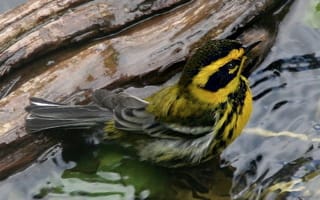 Photo: male by Hari Viswanathan 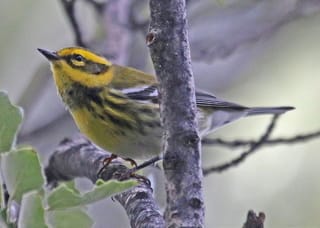 Photo: female by Jerry Oldenettel  Photo: immature by Bill Carrell |  Townsend's WarblerTOWA (Setophaga townsendi, Dendroica townsendi)Family: Parulidae (Wood Warblers) Size: 4.5 - 5 in (11 - 13 cm) Flies: Apr 12 - May 15 and Aug 01 - Nov 01 Morphology: small bird with yellow chest and face, yellow crescent under the eye, stripes down the sides, white wingbars, dark face patch, and dark crown; males have a black crown, throat, and cheek patch along with black streaks that extend down from the throat; females have some thin black markings on the throat but cheek patch is olive; immatures are similar to the females with the exception of no black on the throat Status: native; rare Food source: mostly insects with a few spiders, seeds, and berries Habitat: coniferous forests, Douglas firs Townsend’s Warblers are known for their interesting facial patterns. They forage high up in trees, actively searching for food. They will sometimes fly out to catch an insect in the air and often feed in mixed flocks when not nesting. These birds are attracted to water gardens during the spring and fall migration. Males establish nesting territories by singing. Nests are placed directly on top of a branch usually high up in a conifer. Young leave the nest at about 8 to 10 days of age. Info Photos Range Frequency |
 Photo: male by Hari Viswanathan 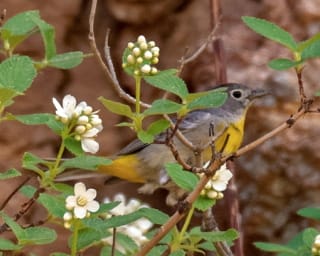 Photo: male by DP Lawrence 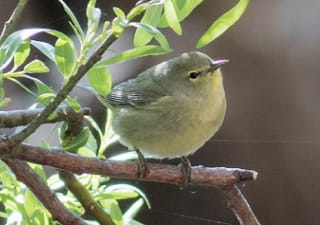 Photo: female by Mouser Williams |  Virginia's WarblerVIWA (Oreothlypis virginiae, Vermivora virginiae)Family: Parulidae (Wood Warblers) Size: 4 - 4.3 in (10 - 11 cm) Flies: Mar 21 - Oct 07 Morphology: adults are gray overall with a white breast and white eyerings; males have bright yellow markings on the chest and under the rump along with a chestnut patch on the crown which is usually hidden; females are pale yellow on the chest and only sometimes have the chestnut patch on the crown Status: native; locally common Food source: not well know, presumably mostly insects Habitat: scrub oak, chaparral, pinyon-juniper, pine-oak woodlands The Virginia’s Warbler is named for the wife of the army surgeon who discovered the bird in New Mexico in 1858. These birds prefer brushy areas and can be seen hopping around shrubs during the spring, summer, and fall but will come to water gardens. They usually taken insects directly off of foliage or flowers but may catch some on the ground or in mid-air. Nests are very hard to find as they are placed on the ground and covered with dense brush. Although nests are rarely parasitized by cowbirds, young often fall prey to jays and snakes. Info Photos Range Frequency |
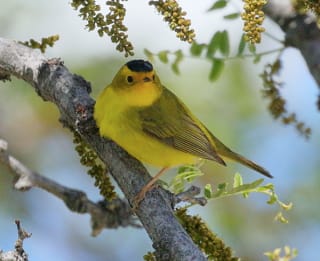 Photo: male by Bob Walker  Photo: female by Bob Walker 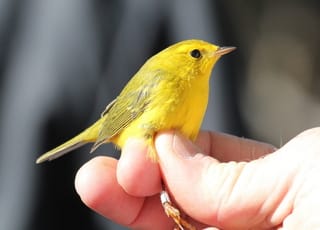 Photo: female by Terry Foxx |  Wilson's WarblerWIWA (Cardellina pusilla, Sylvania pusilla)Family: Parulidae (Wood Warblers) Size: 4.3 - 5 in (11 - 13 cm) Flies: Apr 15 - Jun 15 and Aug 01 - Oct 07 Morphology: males are bright yellow below and yellowish olive above with distinctive black eyes and black cap; females are similar but show variation in the amount of black on the top of the head from a few feathers to enough to form a small cap Status: native; locally common Food source: insects including bees, wasps, beetles, caterpillars, and aphids Habitat: moist thickets in woodlands and along streams; near scrub oaks Typical location: Ashley Pond The Wilson’s Warbler is a small, very active bird that often flips its long tail as it hops from branch to branch while foraging. It will also fly out to catch insects mid-air or hop along the ground probing among fallen leaves for food. These birds will visit water gardens. Open cup nests are usually located on the ground at the base of a shrub or sunken in the ground vegetation. Typically the eggs hatch in 10 to 13 days. The young leave the nest a week or two later. Cowbirds often lay eggs in the nests of these warblers. Info Photos Range Frequency |
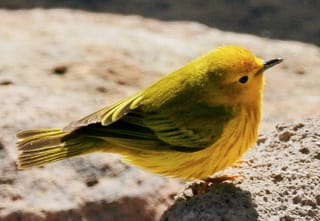 Photo: male by Hari Viswanathan 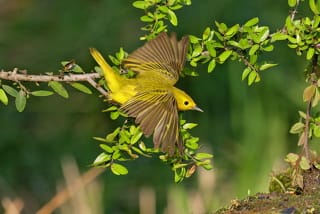 Photo: male by Bob Walker  Photo: female by Bob Walker |  Yellow WarblerYEWA (Setophaga petechia, Dendroica petechia)Family: Parulidae (Wood Warblers) Size: 4.5 - 5 in (11 - 13 cm) Flies: Apr 15 - Oct 01 Morphology: small, uniformly yellow birds with unremarkable large black eyes; males are brighter yellow than females and have reddish streaks on underparts Status: native; uncommon Food source: mostly insects with up to two-thirds of diet consisting of caterpillars of various kinds; also feeds on spiders and some berries Habitat: moist thickets, residential areas Yellow Warblers will visit water gardens during the spring and fall migration. They can also be seen in deciduous trees where they forage among the twigs and foliage, often hovering briefly to reach insects on the undersides of leaves. Males actively court females for several days. Females then build open, cup-shaped nests placed among the branches in a shrub or tree. These nests are easy to find and are often taken advantage of by cowbirds. Yellow Warblers will try to thwart the cowbirds by building a new nest over the old one and laying a new clutch of their own. These birds are persistent and there has been a report of six layers of nests build by one warbler. Info Photos Distribution Frequency |
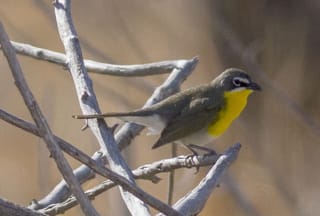 Photo: adult by Mouser Williams 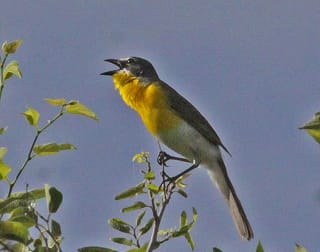 Photo: male singing by Jerry Oldenettel 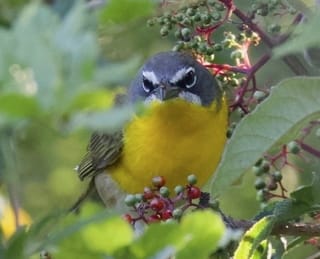 Photo: adult by rudyard |  Yellow-breasted ChatYBCH (Icteria virens)Family: Parulidae (Wood Warblers) Size: 6.5 - 7.5 in (17 - 19 cm) Flies: Apr 21 - Sep 21 Morphology: Adults are olive-green above with a bright yellow breast, white lower belly, gray face, white mustache, and a white eyering that reaches around to form the appearance of “glasses” Status: native; rare Food source: eats a variety of insects, spiders, berries and fruit Habitat: dense thickets, stream side tangles, dry brushy slopes Typical location: White Rock Canyon Yellow-breasted Chats are larger than other warblers. Despite this, they are often hard to see as they hide silently in dense thickets for most of the year. In constrast during the spring, males will make a lot of whistles, hoots, and cackles. Yellow-breasted Chats have a distinctive flight pattern: hovering with slow, deep flaps and dangling feet. They forage by searching through low hanging dense foliage and, unlike other warblers, will fold food with one foot while eating. Nests are concealed in dense shrub and placed fairly close to the ground. Nests are commonly parasitized by Brown-headed Cowbirds. Young leave the nest a little more than a week after hatching. There are usually 2 broods per year. Info Photos Distribution Frequency |
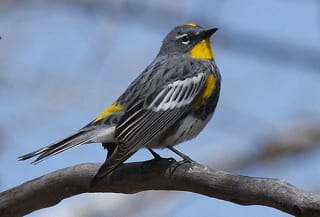 Photo: Audubon male by J.N. Stuart 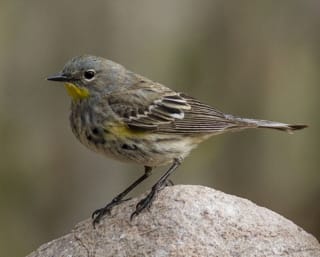 Photo: Audubon female by Mouser Williams  Photo: hybrid male by Mouser Williams |  Yellow-rumped Warbler, Audubon's Warbler, Myrtle WarblerYRWA (Setophaga coronata)Family: Parulidae (Wood Warblers) Size: 5 - 6 in (13 - 15 cm) Flies: Apr 21 - Nov 21 Morphology: in summer both sexes are gray with white on the wings and yellow on the sides and rump, and in winter they are paler with more brown; overall, females are paler and more brown than males ; the “Myrtle” subspecies is characterized by a white throat and dark facial mask; the “Audubon” subspecies is characterized by a yellow throat and more white on the wings; hybrids can show traits of bot Status: native; common Food source: insects, spiders, and berries Habitat: coniferous forests, mixed forests There are two subspecies of Yellow-rumped Warbler: Myrtle, primarily seen in the east, and the Audubon, dominant in the west. These two subspecies can interbreed where their ranges overlap, including the Canadian Rockies. The prevailing subspecies in the local area is the Audubon with the occasional hybrid observed. These birds are the most common warblers in North America and are capable of wintering farther north than other warbler species. They sing from the high canopy of the forest with a chirp or "contact call" that keeps the flock together. Yellow-rumped Warblers have many different foraging strategies: searching among twigs and leaves, flying out to catch prey, hopping along the ground, and clinging to tree trunks and branches. They tend to forage in flocks in winter. They normally have 2 broods per year. Nests are usually found on a branch away from the trunk of a tree. Info Photos Distribution Frequency |
